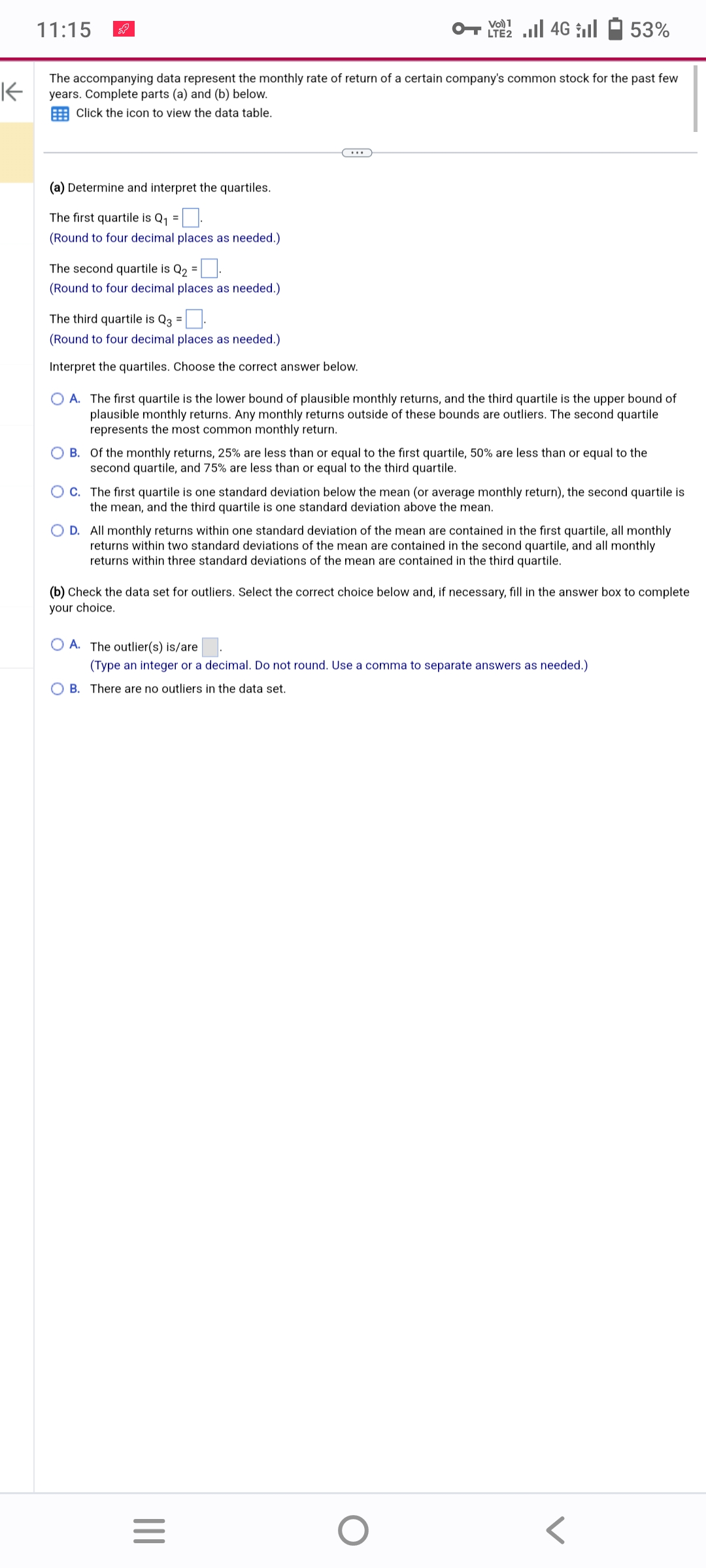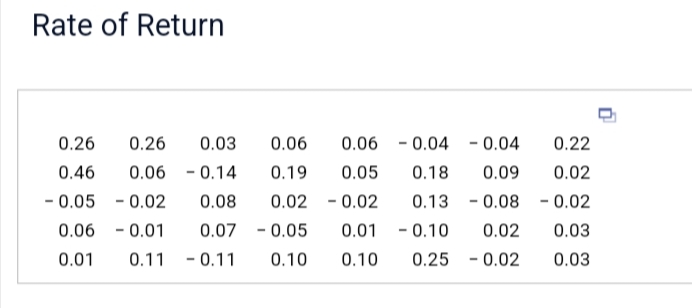(a) Determine and interpret the quartiles. The first quartile is Q₁ = - (Round to four decimal places as needed.). The second quartile is Q₂ = -0. (Round to four decimal places as needed.) The third quartile is Q3 = (Round to four decimal places as needed.). Interpret the quartiles. Choose the correct answer below.
(a) Determine and interpret the quartiles. The first quartile is Q₁ = - (Round to four decimal places as needed.). The second quartile is Q₂ = -0. (Round to four decimal places as needed.) The third quartile is Q3 = (Round to four decimal places as needed.). Interpret the quartiles. Choose the correct answer below.
Functions and Change: A Modeling Approach to College Algebra (MindTap Course List)
6th Edition
ISBN:9781337111348
Author:Bruce Crauder, Benny Evans, Alan Noell
Publisher:Bruce Crauder, Benny Evans, Alan Noell
Chapter5: A Survey Of Other Common Functions
Section5.3: Modeling Data With Power Functions
Problem 3TU
Related questions
Question

Transcribed Image Text:11:15
(a) Determine and interpret the quartiles.
The first quartile is Q₁ =
0.
(Round to four decimal places as needed.)
K
The accompanying data represent the monthly rate of return of a certain company's common stock for the past few
years. Complete parts (a) and (b) below.
Click the icon to view the data table.
The second quartile is Q₂ =.
(Round to four decimal places as needed.)
The third quartile is Q3 =
(Round to four decimal places as needed.)
Interpret the quartiles. Choose the correct answer below.
LTE 2.1 4G
O A. The first quartile is the lower bound of plausible monthly returns, and the third quartile is the upper bound of
plausible monthly returns. Any monthly returns outside of these bounds are outliers. The second quartile
represents the most common monthly return.
OB. Of the monthly returns, 25% are less than or equal to the first quartile, 50% are less than or equal to the
second quartile, and 75% are less than or equal to the third quartile.
53%
OC. The first quartile is one standard deviation below the mean (or average monthly return), the second quartile is
the mean, and the third quartile is one standard deviation above the mean.
O D. All monthly returns within one standard deviation of the mean are contained in the first quartile, all monthly
returns within two standard deviations of the mean are contained in the second quartile, and all monthly
returns within three standard deviations of the mean are contained in the third quartile.
(b) Check the data set for outliers. Select the correct choice below and, if necessary, fill in the answer box to complete
your choice.
A. The outlier(s) is/are
(Type an integer or a decimal. Do not round. Use a comma to separate answers as needed.)
in the data set.
OB. There are no outliers
|||
=
O

Transcribed Image Text:Rate of Return
0.26
0.26 0.03
0.46 0.06 0.14
-0.05 -0.02
0.08
0.06 0.01 0.07
0.01
0.11 - 0.11
0.06
0.19 0.05
0.02
-0.05
0.10
0.06 0.04 -0.04 0.22
0.18 0.09 0.02
-0.02 0.13 0.08 -0.02
0.01 -0.10 0.02
0.03
0.10 0.25 0.02
0.03
-
Expert Solution
This question has been solved!
Explore an expertly crafted, step-by-step solution for a thorough understanding of key concepts.
This is a popular solution!
Trending now
This is a popular solution!
Step by step
Solved in 2 steps

Recommended textbooks for you

Functions and Change: A Modeling Approach to Coll…
Algebra
ISBN:
9781337111348
Author:
Bruce Crauder, Benny Evans, Alan Noell
Publisher:
Cengage Learning

Algebra & Trigonometry with Analytic Geometry
Algebra
ISBN:
9781133382119
Author:
Swokowski
Publisher:
Cengage


Functions and Change: A Modeling Approach to Coll…
Algebra
ISBN:
9781337111348
Author:
Bruce Crauder, Benny Evans, Alan Noell
Publisher:
Cengage Learning

Algebra & Trigonometry with Analytic Geometry
Algebra
ISBN:
9781133382119
Author:
Swokowski
Publisher:
Cengage


Algebra and Trigonometry (MindTap Course List)
Algebra
ISBN:
9781305071742
Author:
James Stewart, Lothar Redlin, Saleem Watson
Publisher:
Cengage Learning

College Algebra
Algebra
ISBN:
9781305115545
Author:
James Stewart, Lothar Redlin, Saleem Watson
Publisher:
Cengage Learning

Glencoe Algebra 1, Student Edition, 9780079039897…
Algebra
ISBN:
9780079039897
Author:
Carter
Publisher:
McGraw Hill